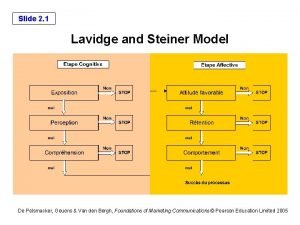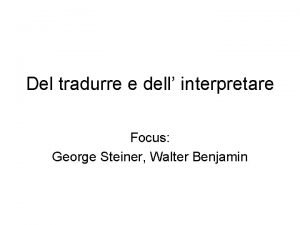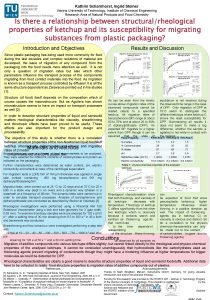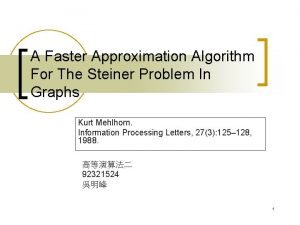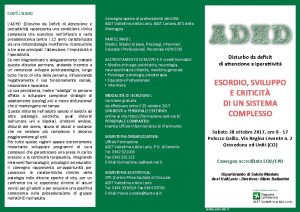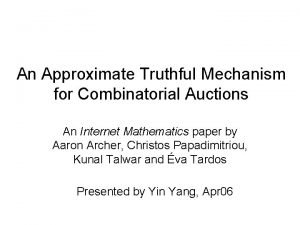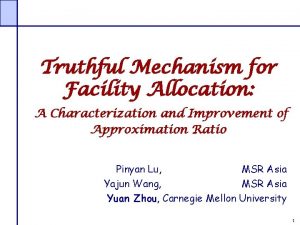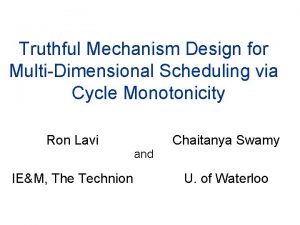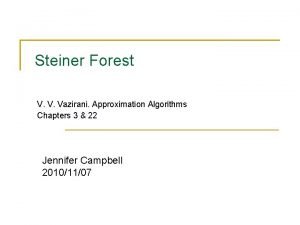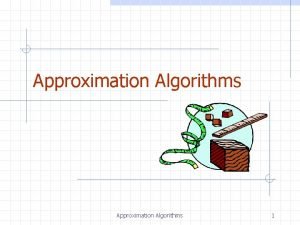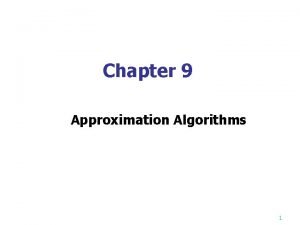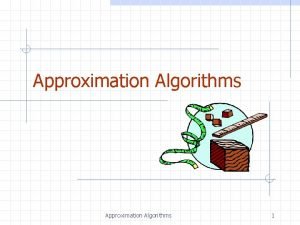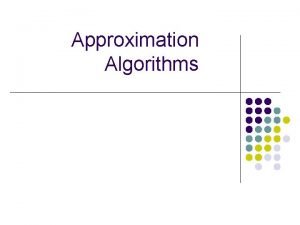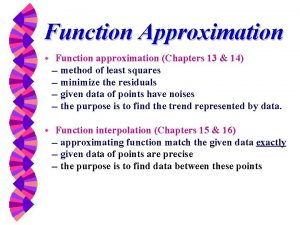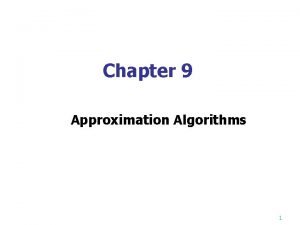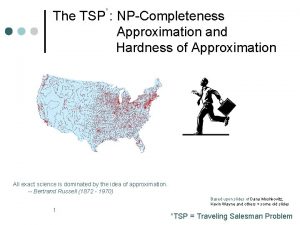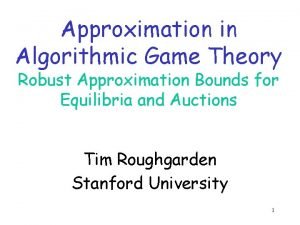A Truthful 2 approximation Mechanism for the Steiner














![Theorem [Takahashi, Matsuyama, ’ 80] The algorithm is a 2 -approximation algorithm for the Theorem [Takahashi, Matsuyama, ’ 80] The algorithm is a 2 -approximation algorithm for the](https://slidetodoc.com/presentation_image/2759f2e104a0caa32b82b197ae538da4/image-15.jpg)
















- Slides: 31

A Truthful 2 -approximation Mechanism for the Steiner Tree Problem

The Steiner Tree problem n INPUT: n n n Undirected, weighted graph G=(V, E, c) N V: set of terminal nodes OUTPUT: n a tree T spanning N of minimum total cost, i. e. , which minimizes c(T)= e Tc(e)

An example a T c 2 4 3 1 1 1 5 2 2 1 b N={a, b, c} 5 3 2 T: optimal Steiner tree

About Steiner Tree problem n n It is NP-hard It is approximable within 1. 55 n Robins, Zelikovsky (2000)

Steiner Tree game n n n Each edge e is controlled by a selfish agent Ae Only Ae knows te (weight of the edge e) We want to compute a “good” solution w. r. t. the true costs We do it by designing a mechanism Our mechanism: n n n Asks each agent to report her cost Computes a solution using an output algorithm g(٠) Hands payments pe to each agent Ae using some payment function p

More formally n Feasible solutions: n n Type of agent Ae: n n n e: weight of edge e Intuition: e is the cost Ae incurs whenever she uses e Ae’s valuation of T F: n n F: set of all trees in G spanning N ve( e, T)= e if e E(T), 0 otherwise SCF: minimum Steiner tree of G=(V, E, ) with terminals N

How to design a truthful mechanism for the problem? Notice that: the (true) total weight of a feasible T is: e E ve( e, T) the problem is utilitarian! …VCG mechanisms apply

VCG mechanism n M= <g(r), p(x)>: g(r): arg minx F j vj(rj, x) n pe(x): for each e E: n pe = j≠e vj(rj, g(r-e)) - j≠e vj(rj, x) g(r) should compute an optimal solution!!! What to do? …we look for (approximated) one-parameter mechanisms! L. Gualà, G. Proietti, A Truthful (2 -2/k)-Approximation Mechanism for the Steiner Tree Problem with k Terminals, COCOON’ 05

Our goal: to design a mechanism satisfying: n 1. 2. 3. g(٠) is monotone Solution returned by g(٠) is a “good” solution, i. e. an approximated solution g(٠) and p(٠) computable in polynomial time

A 2 -approximation algorithm 1. Build the weighted complete graph D with node set N 1. 2. 3. 4. For every pair of nodes in N, w(a, b): = d. G(a, b) Compute an MST M of D Expand any edge of M with the corresponding shortest path. This defines a subgraph H of G Return any feasible tree T which is a subgraph of H

N={a, b, c} An example 5 a 2 3 a 1 10 15 b 3 1 12 2 4 D 8 2 13 2 c 7 7 b 8 c

N={a, b, c} An example 5 a 2 3 a 1 10 15 b 3 1 12 2 4 D 8 2 13 2 c 7 7 b 8 M c

N={a, b, c} An example 5 a 2 H 3 a 1 10 15 b 3 1 12 2 4 D 8 2 13 2 c 7 7 b 8 M c

N={a, b, c} An example 5 a 2 T 3 a 1 10 15 b 3 1 12 2 4 D 8 2 13 2 c 7 7 b 8 M c
![Theorem Takahashi Matsuyama 80 The algorithm is a 2 approximation algorithm for the Theorem [Takahashi, Matsuyama, ’ 80] The algorithm is a 2 -approximation algorithm for the](https://slidetodoc.com/presentation_image/2759f2e104a0caa32b82b197ae538da4/image-15.jpg)
Theorem [Takahashi, Matsuyama, ’ 80] The algorithm is a 2 -approximation algorithm for the Steiner tree problem, i. e. it returns a solution with cost at most twice the cost of the optimal solution. Is the algorithm monotone? . . good question! It depends on Steps 3 and 4

Definition of g(٠) We modify the 2 -apx algorithm in order to garantee n 1. 2. Monotonicity Efficiency w. r. t. the computation to the threshold values Idea: we can guarantee an acyclic expansion of M

High level description of g(٠) 1. Compute D; M=MST(D) 2. Let r be any terminal node. T=({r}, ). N(T)={r} 3. At each step g(٠) reaches a new terminal node b (until N(T)=N) 1. Choose an edge (a, b) of M s. t. a N(T) and b N(T) 2. Try to expand (a, b) whithout forming cycles 3. If this is not possible, look for an edge (a’, b) of D s. t. 1. (a’, b) admits an acyclic expansion 2. a’ N(T) 3. w(a’, b)=w(a, b) 4. M=M{(a, b)} {(a’, b)} 5. Expand (a’, b); N(T) = N(T) {b} 4. Return T and M

Expanding (a, b) n An edge (a, b) admits an acyclic expansion w. r. t. a current tree T if there is a shortest path =PG(a, b) s. t. n n [a, x] is already in the current tree [x, b] passes through no node of T (except x) Notation n Let e’=(a’, b’) E(M) n Removing e’ splits M into two subtrees n N(a’): the node set of the subtree containig a’ n N(b’): remaining nodes n CM(a’, b’): non-tree edges crossing the cut (N(a’), N(b’))

Expanding (a, b) Let =PG(a, b); Let x be the first node of T encountered along (traversing from b to a) Let (a’, b’) be any edge of the current M s. t. : 1. 2. 3. n n n 4. 5. a’, b’ N(T) ’=PT(a’, b’) passes through x a N(a’) N(T)=N(T) {b}; T=T [x, b]; if (a a’) then M=M{(a, b)} {(a’, b)}

Correctness (sketch) n n T is acyclic At any time M is an MST of D we have to show that the expanding step is correct There are 2 cases: n n a=a’ a a’

Case 1 (a’=a) M T c b’ b’ c a a’ x d b a a’ d =PG(a, b) ’=PT(a, x) [x, b] is an alternative shortest path from a to b we expands (a, b) with ’ (acyclic expansion) b

Case 2 (a’ a) T x b’ d a’ c c a’ M a b it must be d. G(a, x)=d. G(a’, x) a b’ d b w(a, b)=w(a’, b) ’=PT(a’, x) [x, b] is a shortest path from a’ to b we swap (a, b) and (a’, b) in M… …and we expands (a’, b) with ’ (acyclic expansion)

Lemma The algorithm g( ) is monotone proof It suffices to prove that any non-selected edge e it still non-selected when Ae raises her bid Notice: e does not belong to any shortest path selected in M Thus, if Ae raises her bid, the only edges in D which increase their weight are edges in E(D)E(M) …M remains an MST of D… …the solution computed by g() is the same and e is not selected

Computing the payments …we have to pay each selected edge e as its threshold value How much can Ae raise her bid before exiting from the computed solution?

Example 1 M a’ a’ a a’’ w(a’, b’) w(a, b) + be b’ b a’’ T a PG(a, b) w(a’’, b’’) + be b’’ e PG(a’, b’) b b’ b’’ Ae raises her bid of be (a’, b’) becomes lighter than (a, b) PG(a’’, b’’)

Example 1 M a a’ a’ w(a, b)+ be w(a’, b’) e w(a’’, b’’)+ be b’ a’’ a b b’’ g(٠) selects (a’, b’) and e exits form the solution b’ b b’’ T

Example 2 M a’ a’ a a’’ b’ b T a PG(a, b) w(a’’, b’’) + be w(a, b) w(a’, b’) d. G-e a’’ b’’ e PG(a’, b’) b b’ b’’ Ae raises her bid of be PG-e(a, b) becomes shorter than PG(a, b) is still a lightest edge crossing the cut PG(a’’, b’’)

Example 2 M a’ a’ a a’’ w(a’, b’) d. G-e(a, b) b’ b a’’ T a w(a’’, b’’) + be b’’ PG-e(a, b) e PG(a’, b’) b b’ b’’ g(٠) still selects (a, b) but e exits from the solution PG(a’’, b’’)

…more formally… The image of e on M Im(e)={(a, b) E(M) | e PT(a, b)} (a, b) The threshold e is defined as for e w. r. t. the edge (a, b) Im(e) (a, b) e =be + min {(d. G-e(a, b) – d. G(a, b)), (swap(a, b)(e) – d. G(a, b))} where swap(a, b)(e)= min {d. G-e(a’, b’)} (a’, b’) CM(a, b)

Threshold of e If Im(e)={(a 1, b 1), … , (ah, bh)} (ai, bi) e = max { e i=1, . . , h } Easy to see: e can be computed in polynomial time

Theorem The running time of the mechanism is O((n+k 2)m log (m, n). The space used is O(n 2).
 Rudolf steiner franziska blie steiner
Rudolf steiner franziska blie steiner I am not cruel only truthful
I am not cruel only truthful Adolf loos steiner house
Adolf loos steiner house Dr. magdalena steiner
Dr. magdalena steiner Lisa steiner model
Lisa steiner model Ruben steiner
Ruben steiner Natural selection furniture
Natural selection furniture Script matrix transactional analysis
Script matrix transactional analysis Lavidge and steiner model
Lavidge and steiner model Lavidge and steiner
Lavidge and steiner Anita steiner kommunikation
Anita steiner kommunikation George steiner dopo babele
George steiner dopo babele Steiner hermeneutic motion
Steiner hermeneutic motion Examples of social loafing in sport
Examples of social loafing in sport Steiner colour theory
Steiner colour theory Aria at steiner ranch
Aria at steiner ranch Matrice di copione steiner
Matrice di copione steiner Bishop sandra steiner ball
Bishop sandra steiner ball Steiner's theorem
Steiner's theorem Ingrid steiner
Ingrid steiner Rudolf steiner theory
Rudolf steiner theory Steiner
Steiner Artur steiner
Artur steiner Naomi steiner
Naomi steiner Aim icons dollz
Aim icons dollz Kellerbereich
Kellerbereich Vera steiner psichiatra
Vera steiner psichiatra Steiner-muller economy classification system
Steiner-muller economy classification system Steiner
Steiner Steiner
Steiner Tehetetlenségi nyomaték számítása
Tehetetlenségi nyomaték számítása Flächenträgheitsmoment steiner
Flächenträgheitsmoment steiner









